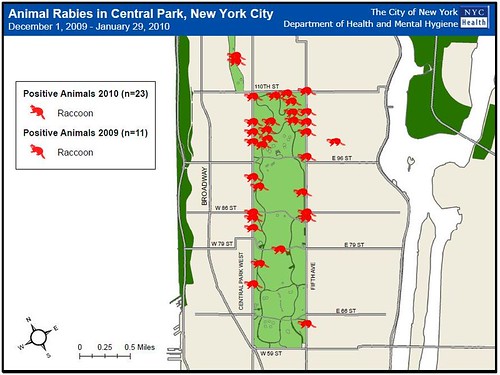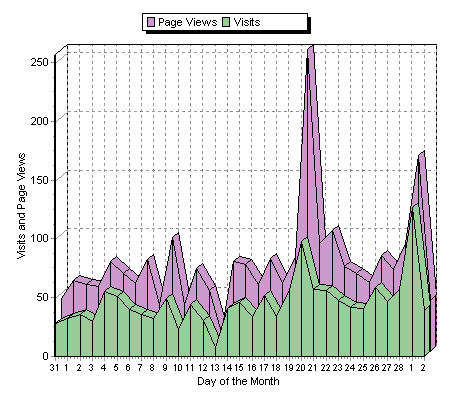With all of the recent interest in raccoons and other wildlife, rabies is frequently raised as a concern. The New York City Department of Health has information on rabies on its Web site. Anyone concerned about the risk of exposure to rabies from interactions with wildlife in NYC should review the DOH information, which I’ll summarize here:
- There have been no human cases of rabies in New York City for more than 50 years. In all of New York State, there have only been 14 cases since 1925.
- Staten Island, with 29 rabid animals reported last year, and 35 in 2006, has a greater incidence of rabid animals than the rest of the city combined. The risk there is serious enough that DOH has issued a Rabies Alert [PDF, English/Español] for Staten Island.
- The Bronx, with 14 reports last year and only 6 the year before, has less than half the incidence of Staten Island.
- Brooklyn has had only 5 rabid animal reports in the past 15 years, and only 1 in the past 5.
- Although city-wide, raccoons are the most frequently reported rabid animal, in Brooklyn no raccoons have been reported in the past 15 years.
So, although caution is always wise, there’s no need to fear these animals. Except for Staten Island, the risk of exposure is extremely low. Spending time outside in New York City, you’re more at risk from West Nile Virus than rabies.
(NYC DOH)
Rabies is a preventable viral disease of mammals (including humans) most often transmitted through the bite of a rabid animal. The rabies virus infects the central nervous system. Rabies is almost always fatal once symptoms appear. The vast majority of rabies cases in the United States each year occur in wild animals like raccoons, skunks, bats, and foxes. Animal rabies is reported annually in New York City and State, primarily in bats, skunks and raccoons. New York City first saw rabies in animals starting in 1992, and continues to every year, especially among animals in the Bronx.
In the United States, rabies rarely infects humans because of companion animal vaccination programs and the availability of human rabies vaccine. There have been no human cases of rabies in New York City for more than 50 years. New York State has reported 14 human cases since 1925.
Human rabies vaccine, if administered promptly and as recommended, can prevent infection after a person has been bitten or otherwise exposed to an animal with rabies. The human rabies vaccine is given in a series of five vaccinations along with one initial dose of rabies immune globulin (RIG). The one time dose of RIG and five vaccines administered over the course of one month is referred to as post exposure prophylaxis (PEP).
(New York State Department of Health)
Don’t feed, touch or adopt wild animals, stray dogs or cats.
Be sure your dogs, cats and ferrets are up-to-date on their rabies vaccinations. [Note: This is the law in New York City.] Vaccinated pets serve as a buffer between rabid wildlife and man. Protect them, and you may reduce your risk of exposure to rabies. Vaccines for dogs, cats and ferrets after three months of age are effective for a one-year period. Revaccinations are effective for up to three years. Pets too young to be vaccinated should be kept indoors. Some new vaccines have now been licensed, and therefore, can be used for younger animals.
Don’t try to separate two fighting animals. Wear gloves if you handle your pet after a fight.
Keep family pets indoors at night. Don’t leave them outside unattended or let them roam free.
Don’t attract wild animals to your home or yard. Keep your property free of stored bird seed or other foods that may attract wild animals. Feed pets indoors. Tightly cap or put away garbage cans. [And your compost bins containing food waste or scraps.] Board up any openings to your attic, basement, porch or garage. Cap your chimney with screens.
Bats can be particularly difficult to keep out of buildings because they can get through cracks as small as a pencil. Methods to keep bats out (batproofing) of homes and summer camps should be done during the fall and winter. If bats are already inside (e.g., in an attic or other areas), consult with your local health department about humane ways to remove them.
Encourage children to immediately tell an adult if they are bitten by any animal. Tell children not to touch any animal they do not know.
If a wild animal is on your property, let it wander away. Bring children and pets indoors and alert neighbors who are outside. You may contact a nuisance wildlife control officer who will remove the animal for a fee.
Report all animal bites or contact with wild animals to your local health department. Don’t let any animal escape that has possibly exposed someone to rabies. Depending on the species, it can be observed or tested for rabies in order to avoid the need for rabies treatment. This includes bats with skin contact or found in a room with a sleeping person, unattended child, or someone with mental impairment. Bats have small, sharp teeth and in certain circumstances people can be bitten and not know it.
Links
NYC Department of Health: Rabies (Hydrophobia)
New York State Department of Health: Rabies



